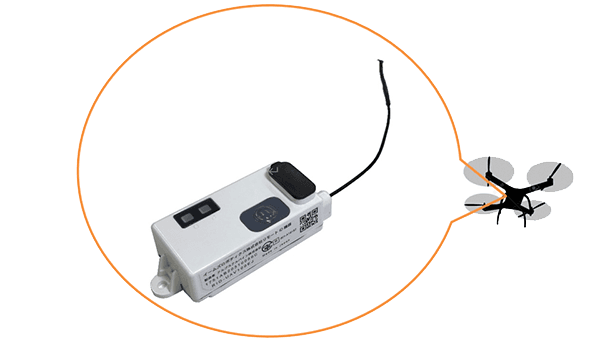Alps Alpine to start mass-producing “remote ID device” for drones – sUAS News
Alps Alpine Co., Ltd. (TSE: 6770; Chief Executive Officer: Toshihiro Kuriyama) developed the “Remote Identification Device”, a radio transmitter for unmanned aircraft (drones). The remote identification device transmits drone identification data, including unique identifiers (registration IDs) and location information, and complies with the specifications prescribed by the Japanese Ministry of Land, Infrastructure, Transport and Tourism (MLIT). Mass production will begin around the end of May 2022, before other companies and before the entry into force of amendments to the Civil Aeronautics Act on June 20 which make it mandatory to register drones and display drone identifiers. ‘registration.
The device is already slated for use by Japanese industrial drone manufacturer EAMS Robotics Co., Ltd. (Headquarters: Fukushima Prefecture; Chief Executive Officer: Eiji Soya). EAMS Robotics will also be an intermediary for sales to other drone manufacturers, having links with experts and companies in the drone industry. In addition to drones, Alps Alpine is considering an application to other forms of mobility and will continue its development with the aim, in the context of a shrinking and aging population, of contributing to a future society where people and robots will move with more comfort, safety and peace of mind.
Development context
In Japan, a low birth rate and an aging population are causing a dramatic contraction in the working-age population – people between the ages of 15 and 64. According to the Ministry of Interior and Communications (MIC)2, Japan’s working-age population as of October 1, 2021 was 74,504,000, down 584,000 from a year earlier. This was 59.4% of the total population – the smallest it had ever been. And the trend should accelerate. The shrinking working-age population affects society in several ways, the biggest concern being the potential economic decline due to a shortage of workers. Government and business have made efforts in recent years to increase the number of workers by creating better working environments for women and the elderly, but it is essential that the workforce receives a further boost. more important in the face of the accelerated contraction of the available population. .
Drones are seen as a tool to help offset the labor shortage. In regions where the above trends are particularly pronounced, a compelling case can be made for the use of drones in logistics as a method of short-haul transport connecting the last mile between local distribution centers and the point of delivery. final. Drones can also be used to safely and efficiently carry out inspections of infrastructure or other equipment or facilities in high places, hilly terrain or other places where the work may be dangerous or inefficient, without human labor. . However, problems remain, such as the risk of drone collisions in the air and the difficulty of locating a drone to recover it after a crash.
Amendments to the Civil Aeronautics Act dealing with these issues will come into force on June 20, 2022. It will become mandatory for drones with a take-off weight of 100 grams or more to be registered with the registration system of DIPS-REG drones administered by the MLIT and for registration identifiers to be displayed on the drones. Unlike a license plate on an automobile, however, the information displayed on a drone cannot be confirmed from the ground while it is in flight. Drones will therefore need to carry remote identification equipment to transmit registration identification and other data via radio waves.
Development overview
The remote identification device developed by Alps Alpine, in accordance with the specifications prescribed by the MLIT, transmits the identification data of the drone, including unique identifiers (registration identifiers) and location information, using of radio waves. Since the equipment can be affixed retroactively to a drone, previously used customer drones can be made compliant with the standards set out in the Civil Aeronautics Act.
A drone’s position is tracked using a built-in Global Navigation Satellite System (GNSS) function and its registration ID is transmitted using a Bluetooth-enabled module developed by Alps Alpine ® 5.0 Low Energy Long Range. The communication range in actual use reaches at least 1500 meters. The ID is retrieved and confirmed using a special application. The barometric altitude is supported by an atmospheric pressure sensor developed by Alps Alpine. Compact size and light weight are achieved with the main body measuring 60×30×18mm (W×H×D) and weighing 33 grams despite carrying a lithium-ion battery. In addition, know-how acquired in the automotive sector is applied to achieve IP54 dust and water resistance for excellent reliability. The functionality can be extended by connecting an external device to the USB connector. In the future, we will also realize extension of functions by updating software, applying communication technology not limited to transmission of registration ID.
Outlook
In anticipation of expanded scenarios for the use of drones, Alps Alpine will partner with Japanese industrial drone manufacturer EAMS Robotics and jointly advance sales targeting industrial drones. We will also explore future application to other forms of mobility that will likely need to support remote location using unique identifiers in the context of an accelerating aging society and emerging economy. sharing. This could include electric carts for the elderly, equipped with an obstacle detection unit3 like the one developed by Alps Alpine, and share bikes. With an aging population, our goal is to help create a society where coexisting people and robots can move around with greater convenience, safety and peace of mind.


Comments are closed.